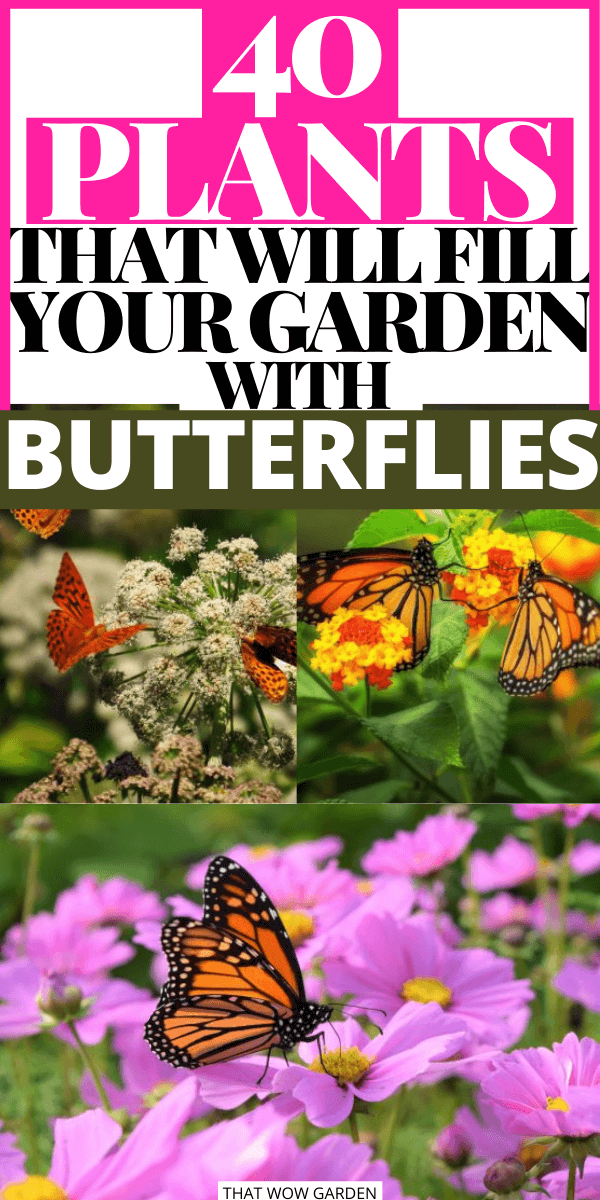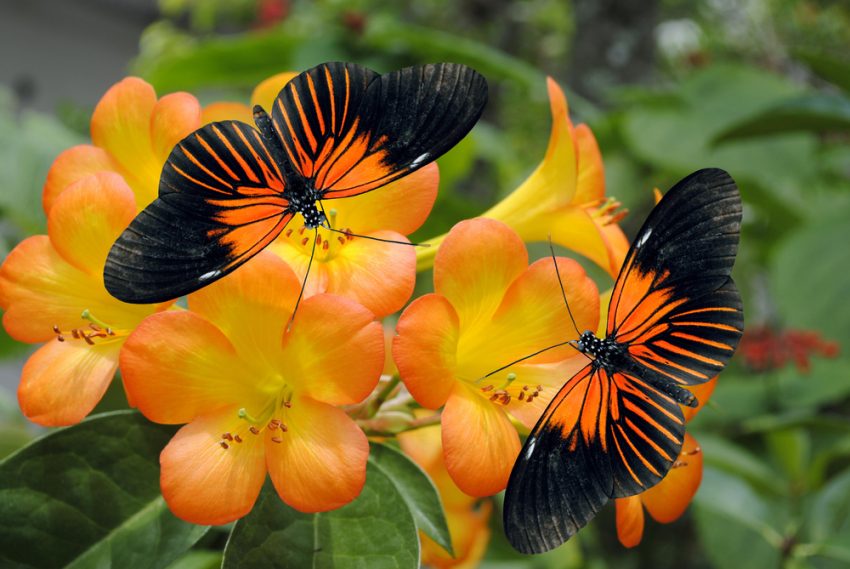Graceful butterflies flitting and swaying from one plant to another- isn’t it an amazing sight? Gardeners love to see their green thumbs coming alive and they have a plethora of choices when it comes to hosts for butterflies and other pollinators. Butterfly gardens are quite popular nowadays and the credit would go to those vibrant blooms and of course, sassy butterflies!
Butterflies have a heightened sense of smell and they are attracted to the sweet nectar of many plants. Additionally, they are attracted to vivid colors like pink, purple, white, yellow, and bright-blue. Butterflies and certain pollinators also prefer flat or dome-shaped clusters of small flowers as they can safely perch on the drink.
How to Choose the Right Plant for Attracting Butterflies
When it comes to choosing the right flower for your butterfly garden, you have to select between a nectar source or host plants. Among hundreds of choices available, all the species have different characteristics and maintenance needs. It can get quite intriguing, I know, and here we are to help you with the selection process!
The key here is to analyze your requirement and what kind of gardener you are- beginner or expert, and that’s it. From popular flowers like Shasta daisy, bee balm, and butterfly bushes, we also have famous herbs like sage and oregano that could make the butterflies go dancing!
40 Plants that Attract Butterflies
1. Bee Balm
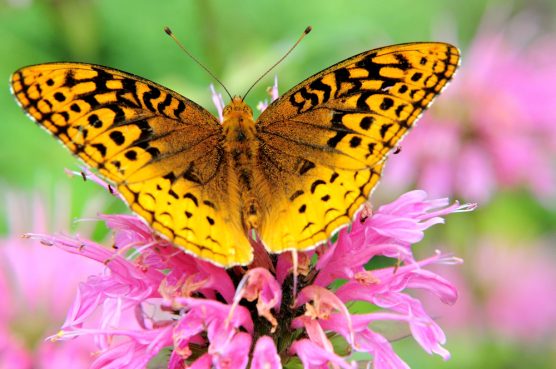
Monarda or Bee Balm is a North American native mainly thriving in the woodland areas of the continent. These are open, tubular, pretty daisy-like flowers that grow once a year and cheer your garden up with vibrant red, white, pink, and purple colors.
Among several varieties, there are dwarf varieties of bee balm that would be like 10 inches and they look super cute. These love to get picked and in fact, if you pick the flowers frequently, you will encourage flower production!
Monarda loves moist, rich soil and lots of sunlight. If you are growing it in a hot and humid area, keep it in a shade. Keep the soil moist and use an all-purpose fertilizer once a month and you are good to go. It might die in cold winters but will grow back when the spring comes.
Since bee balm is very attractive to bees, hummingbirds, and butterflies, make the blush extra flashy by encouraging flower growth as much as possible and I am sure it would be an amazing addition to your butterfly garden!
2. Shasta Daisy
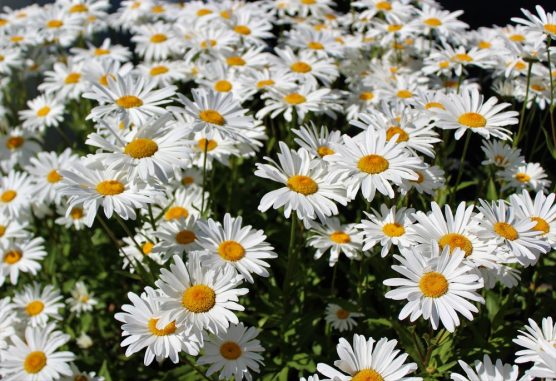
Yes, the one with those striking white petals and pale-yellow floret center, Shasta daisy bears perky summer blooms that offer a traditional look along with evergreen foliage. Mainly used for filling in bare spots in a garden, daisy blooms can attract pollinators and butterflies do love their scent.
Leucanthemum x superbum is a low-maintenance perennial that would make your garden landscape worthy of compliments. Though the blooms are shortlived, you must continue planting Shasta daisies for a year and it will continue to colonize and bless the landscape for a few years.
Before you grow a Shasta daisy plant, prepare the soil properly. Good drainage, like several inches down the soil, moderate light shade, and fertile soil would do the job. By adding organic compost to the soil, you can make these beauties blush!
3. Butterfly Bush
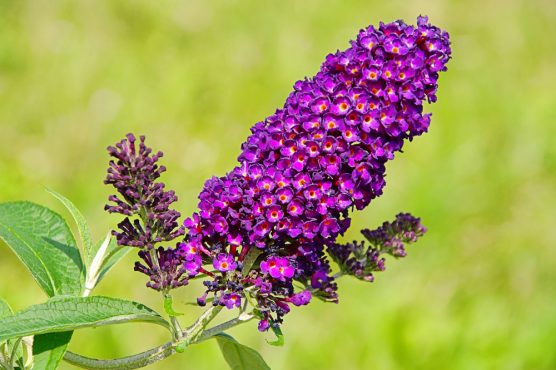
Buddleia davidii or Butterfly Bush are renowned for their long panicles of colorful flowers which are extremely showy. Blooming in spring and summer, their greatest ability is to attract butterflies and beneficial insects. The foliage is attractive as well and hence, the bush looks appealing without the blooms as well.
If you grow a butterfly bush in an optimum location, you would reduce the maintenance time and effort. Since the butterfly bush is considered invasive in many ecological environments, ensure that the plant is permitted in your area before growing.
The location should be sunny or partly shaded, it thrives on well-drained soil as it is prone to root rot and plenty of room because it can get bigger than you have imagined. The deadheading thing could be a pain and you must remove the flower clusters promptly so that the seed pods do not emerge and give birth to weedy young plants.
4. Coneflower
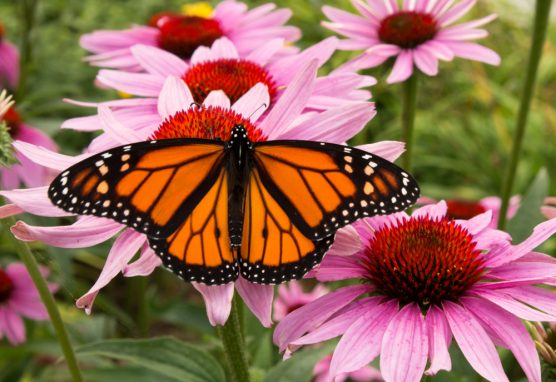
Coneflower or Echinacea purpurea is an eastern United States native and is a regular member of many flower gardens. They can efficiently draw plenty of bees and butterflies in the garden or flower bed and those purple, daisy-like flowers are eye candies.
This plant has sturdy stalks that provide a tall background or repeating rows of showy blooms and the alignment looks really pretty. The birds love to eat all the seeds and if you want to grow another plant next year, collect them in a brown paper bag. Purple coneflower plants that have been on the ground for three or more years, they can start root division from fall.
Coneflower grows best in poor or lean soil as the blooms are prominent. Rich or heavily fertile soil would result in lush foliage with poor flowering.
Purple coneflower is a plant that needs full sun for at least six hours each day and they do not require watering when the rainfall is normal. If the blooms begin to look ragged in late summer days, cut 1/3rd of the plant as this could rejuvenate it and you might get a new display of fresh blooms!
5. Goldenrod
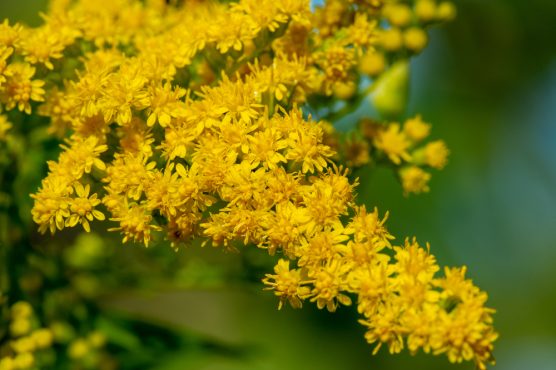
Goldenrod with the botanical name of Solidago, is a flower from the natural summer landscape which is sometimes considered a weed. Topped with plumes of fluffy vibrant yellow flowers, goldenrod has several uses in today’s world and the most significant would be providing shelter to larvae of beneficial insects.
Goldenrod provides ample nectar to migrating butterflies and bees, encouraging them to stay back in your garden and pollinate the area. You can plant goldenrod near a vegetable garden to draw bad bugs away. This clump-forming vibrant wildflower has more than a hundred varieties and most of them are low-maintenance.
Well-draining soil and full sun, that’s it. These stunning yellow flowers can survive on rainwater and what can be better? Once established in the landscape, the plant returns every year to grace your butterfly garden!
6. Baptisia
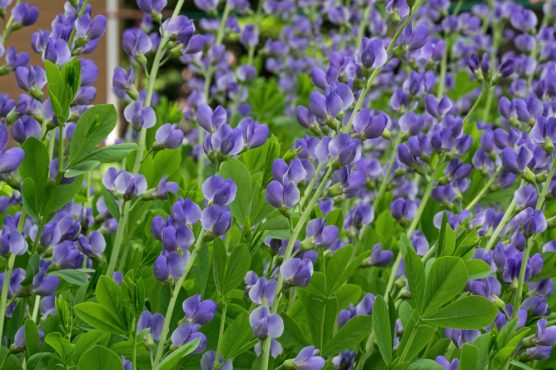
A striking and attractive perennial that doesn’t need much care, Baptisia or false indigo is a plant that has got those looks and even the hummingbirds and butterflies couldn’t ignore its beauty. This rich in nectar species was once used by early Europeans as a source of dye before indigo was available for the purpose.
Belonging to the pea family, baptisia blooms are also white and yellow, not so famous and rare. The renowned indigo blooms are Baptisia australis and they bloom for about six weeks in the spring or early days of summer. The plant produces flower spikes, known as racemes and there could be hundreds of spikes in one garden, a divine sight!
Baptisia prefers well-drained soil, and the deep root system takes time to get established. You might need three years of patience before those seeds get mature enough and blooms appear. Chose the right place as baptisia doesn’t like to be relocated and a yearly dose of garden fertilizers would keep it smiling.
7. Dutchman’s Pipe Vine
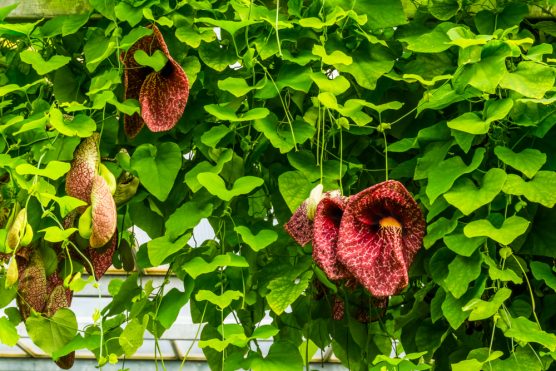
If you think only showy and colorful flowers have got enough nectar to attract butterflies, Dutchman’s pipe vine would prove you wrong. A unique species, Aristolochia macrophylla produces curved pipe-like flowers amidst heart-shaped leaves. The woody vine doesn’t have a sweet odor, instead, they attract pollinators with a rotten meat-like odor.
Pipe’s vine can be 15 feet long when fully grown and it would require a trellis or vertical support for those twining stems. The tinged, plum-colored flowers appear in late spring or early summer. The pipe vines are also hosts for swallowtail butterflies and habitat to several beneficial insects.
From sunny to partially sunny locations, moist soil, and sowing the seeds indoors, it is pretty easy to care for pipe vines and they would hardly cause you trouble. Water is the biggest need of Dutchman’s pipe and you should never let the soil dry out. Fertilize annually before the blooming season and prune it to keep the size manageable.
8. Angelica
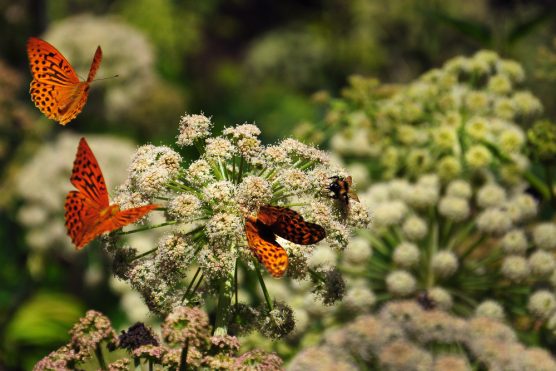
A famous member of the herb garden, angelica is very popular in Scandinavian countries and it grows wild in Russia and Iceland. The Angelica plant has a long history of use as a seasoning herb, a medical plant, and even a tea. This plant is mostly cultivated in cooler countries and they are rich in nectar, hello pollinators!
The umbrella-like flowers are very showy and unique but the blooms only show up once every two years. The herb has a pungent, musky scent but you would definitely recognize the sweet flavor.
Angelica is a well-known flavoring agent for liquors like gin and vermouth. So, the next time you sip into that Martini, savor the flavor of angelica!
Angelica would blush if you grow it indoors in a cooler climate or give it a semi-shady location. For hot climates, plant it in a dappled shade location to protect it from heat. Keep it in well-drained soil with proper heat exposure and be very careful with the pruning and propagation of this herb.
9. Yarrow
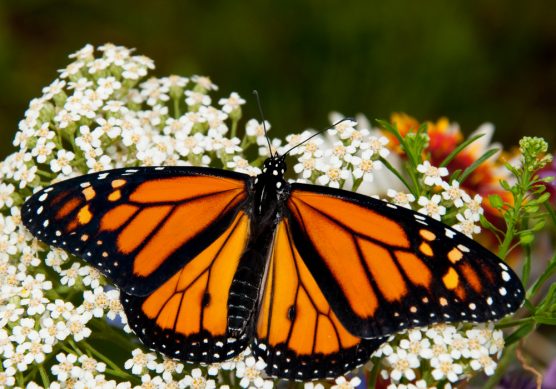
Achillea millefolium or the yarrow plant could be a good addition to your butterfly garden and this flowering perennial is also a herb. It is a care-free plant and it won’t cause you any pain, just vibrant red, yellow, and white flowers!
Most often propagated by division, yarrow plants can also be grown from seeds and to sow seeds, you would need moist, normal potting soil. The yarrow plant loves sunshine and you must decide its location accordingly. Though they can thrive well in very poor, dry soils, it will do the best in well-drained and healthy soils.
The vibrant yellow and pink yarrows are a must-have for every butterfly bush as they form an amazing resting place for traveling butterflies. Some people also border their herb gardens with these lively blooms to impart more flavor to the herbs.
10. Garden Phlox
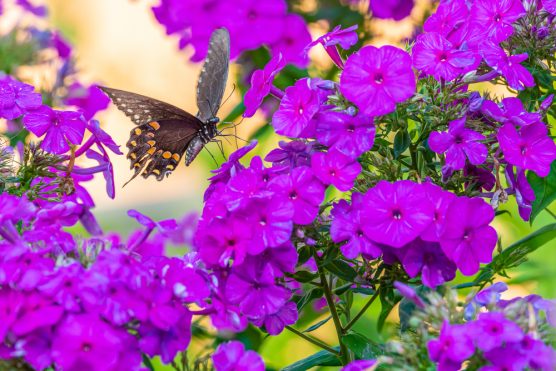
You can choose from a wide range of phlox varieties for your garden and most of them would have soothing colors. Garden phlox is literally the winner amidst its sisters in terms of appeal and those large clusters of pink, lavender, and purple are ideal for sunny borders, full of nectar for butterflies.
Growing this hardy perennial is quite easy unless your harden has a hot and humid climate. These sun-loving flowers have a long flowering season and they enjoy moist well-draining soil. They are prone to powdery mildew and you must look out for the affected leaves and pinch them off the plant.
For growing in humid climates, you must choose a location with good air circulation and don’t let the foliage dry out. Fertilize it with compost regularly to keep it healthy and happy and if you fertilize right after the flowers fade, you might get another flush of flowers!
11. Sunflower
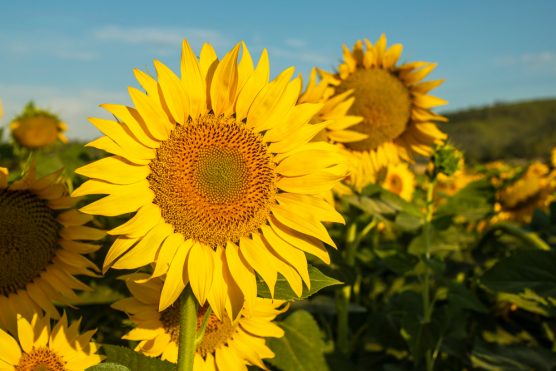
Helianthus annuus or the mighty sunflower is one of the easiest plants to add to your garden and butterflies think they are very tasty as well. If you are a beginner, this one is definitely for you. You will get that joy of planting those big black and white seeds and see them grow into yellow wonders soon.
Not only butterflies but sunflowers can also attract some local birds to your garden and I know a butterfly is tough to resist. From dwarf to tall varieties, sunflowers can be over 12 feet tall when fully grown. The single layer of petals range from pale yellow to dark burgundy and reds and they are a treat to the eyes.
Sunflower is called so because they need full sun and you don’t have to be picky about the soil. They are fine with moist, decent quality soil. If you are a birdfeeder, sunflower seeds are always there for them and the sight would be amazing in winter when the migrating birds take a stop and eat.
12. Joe-Pye Weed
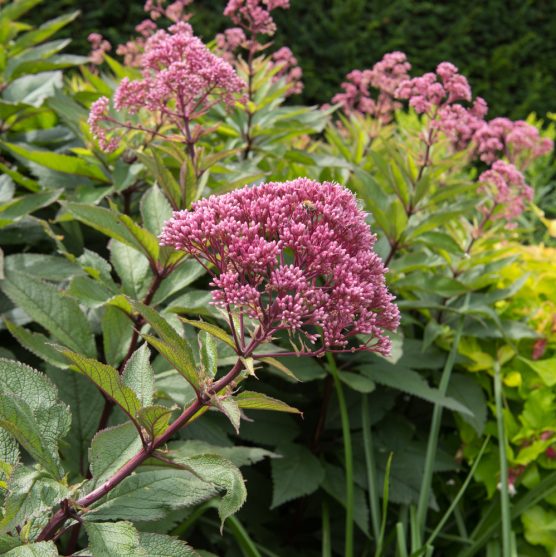
Far from unwanted weed species, Eupatorium purpureum or Joe-Pye weed is an attractive plant that produces pale or light pink-purple flowers. The flowers last from mid-summer to fall and it attracts a multitude of butterflies for its sweet nectar.
A must-have for wildlife lovers, Joe-Pye weed would be a priced addition to your garden because it has medicinal properties, and can be used to produce a pink or red dye. These blooms have a light vanilla fragrance that could be intense if you crush the weeds.
Joe-Pye weed prefers full sun to partial shade when grown in the garden and moderately moist, rich soil would make it blush. They can live with overly wet soil, but dry soil is a big no! These ornamental beauties form large clumps and are often combined with similar woodland plants to make a full-fledged background flower bush.
13. Liatris
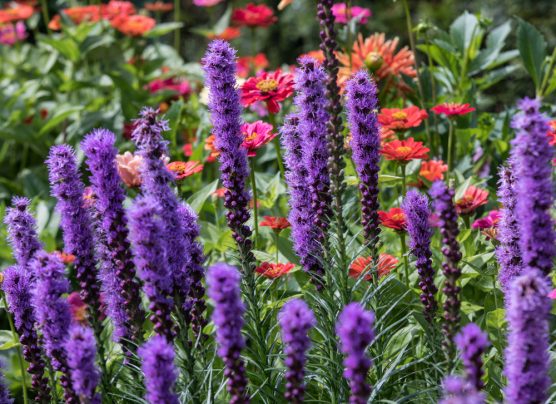
One of the most versatile and easy to grow species, Liatris blazing star plants is not only attractive with thistle-like blooms but they are also butterfly magnets. Liatris flowers from the tall spikes from mounds of narrow, grass-like leaves, and these usually purple flowers bloom from top to bottom instead of bottom to top blooming like most species.
Together with the attractive blooms, the foliage remains green throughout the blooming season before they turn red-bronze in fall. You can grow Liatris anywhere, bed, borders, and even containers.
They love the sun, can effectively handle drought and can accept any soil type including rocky terrains. They are pest resistant, cold tolerant and the list goes on.
14. Snapdragon
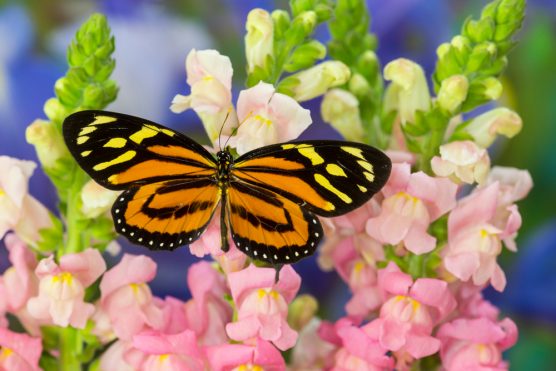
Antirrhinum majus or snapdragon is a famous ornamental flower and you would find these in showy bouquets. The cool season colored blooms are perfect background plants and they attract ladybugs, butterflies and other pollinators.
The fragrant species can tolerate frost, and the blooms are always abundant with high performance. They love to feel full sun and gardeners use well-placed clips to manipulate the reach of this plant and turn it into a bushy, filled-out member of the garden.
Grow it in well-draining soil, keep it moist during the first few weeks and later provide an inch of water every week to make it smile. If you want the plant to survive more than a year, make sure you get rid of the spent blooms and you would encourage the plant to return next year.
15. Bluestar
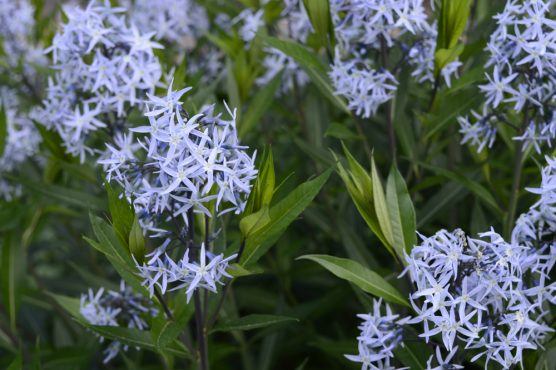
If you want to add something unique and catchy to your butterfly garden, Amsonia or Bluestar would be the right choice for you. A North American native, Bluestar emerges in spring with willowy foliage and forms loose clusters of half-inch, star-shaped blue flowers that cover the entire plant with its splendid beauty. These are perfect for cottage gardens or along woodland streams and beds and borders.
Amsonia grows well in constantly moist soil and they prefer full sun. They can thrive in partial shade but too much shade can cause the plant to sprawl or flop open. A humus-rich soil with organic mulch, thorough watering when the surface feels dry, and no watering in fall would keep this plant happy and you would be gifted with starry blooms that attract butterflies.
16. Cockscomb Flower
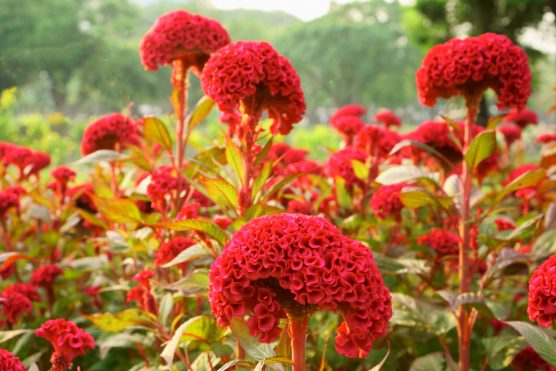
Celosia cristata or cockscomb flowers could be an amazing annual addition to your home garden or flower bed with those red, yellow, pink, white, and orange blooms. The cockscomb plant is super versatile in height and color and they are low-maintenance as well. Celosia is well-known for adding color to a rock garden, the blooms can also be dried up and used in indoor decorations.
To care for a celosia, full sun, rich, well-draining soil, and limited watering are required. Learning how to grow those pretty golden yellow, vibrant purple, and traditional red flowers can be an interesting chore since these heat-loving species are drought tolerant and would hardly cause you any trouble. Also, they can attract pollinators with its rich nectar and you would love that, right?
17. Ageratum
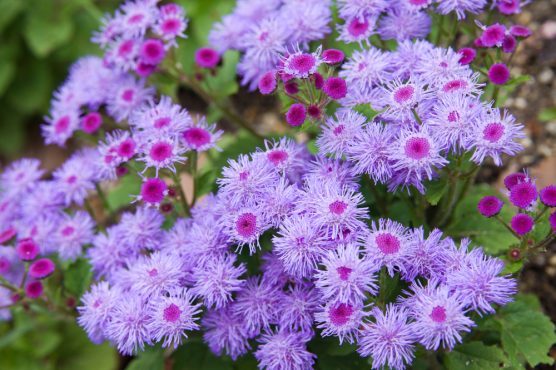
Ageratum plants bear magnificent blue flowers that are easy to maintain and they would grow well even if you are a beginner. Looks amazing in a flower bed or borders, these blooms offer soft, fluffy, and round flowers that come in various shades of blue, white, or pink. If you grow it from seeds, you will find hybrid varieties and those blooms are royal blue.
Ageratum species require full sun and you must water it regularly to keep it healthy enough for the blooms to show up. Deadhead the spent blooms at the end of summer and you might get to see another round of fresh blooms. These pretty blue blooms also attract migrating butterflies and other pollinators.
18. Cosmos
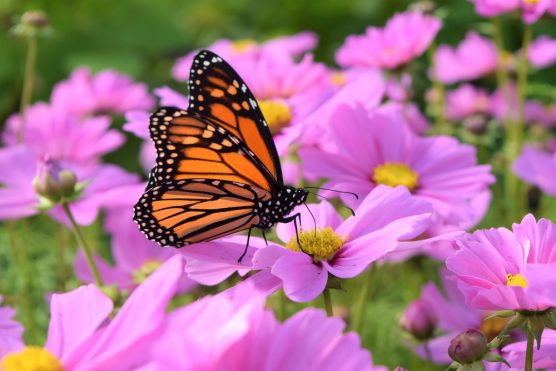
Cosmos bipinnatus or simply cosmos is a well-known flowering plant, thanks to those showy, daisy-like blooms, essential for many summer gardens. These single or double blooms on stems would be an amazing addition to your garden if you want pollinators like butterflies to take a tour.
Used as screening plants in a landscape, cosmos flowers are also used in indoor and background displays. The pretty daisy-like blooms appear atop tall stems adorned with lacy foliage.
The optimum condition for a cosmos plant would be hot, dry weather, and poor to average soil. The bright flowers are hardy and you don’t have to water it regularly, watch out for the dry soil, and do not over-fertilize it. Like many annuals, the cosmos is self-sufficient and a very rewarding flora species!
19. Zinnia
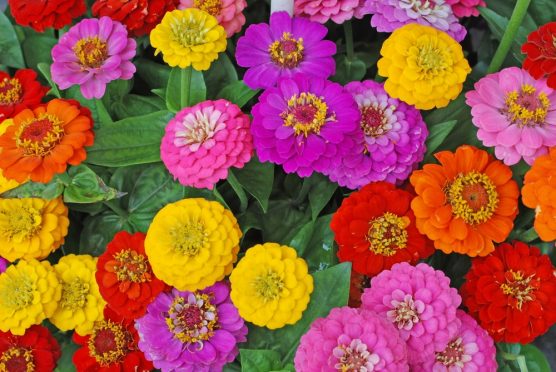
Zinnia elegans are a colorful and long-lasting addition to your flower garden and they are quite rewarding once you learn how to plant them in your area. This inexpensive species can be directly sown into sunny flower beds or you can use this plant as a filler in your flower garden. If you live in a temperate zone, zinnias would begin growth when the temperatures are above 50F and you must start seeds six weeks before the last frost date.
Grow zinnia in fertile, well-drained soil and give it full sun. Use a soaker hose to keep the foliage and petals moist and it is advised to water it in the early morning so the plant can absorb it before nightfall. If you take good care, it will reward you with a colorful summer garden, abundant blooms, and regular butterfly visits!
20. Lantana
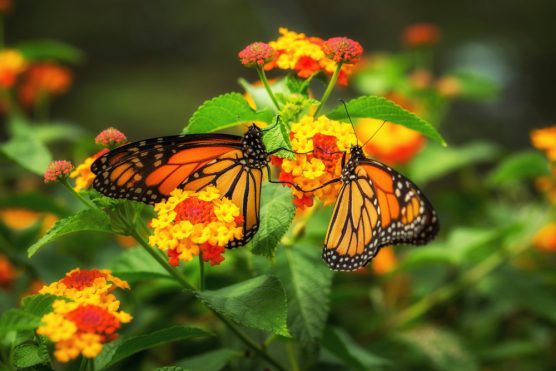
Lantana camara has verbena-like blooms which are always admired for their extended bloom time. Having several colorful varieties, lantana can be treated as both perennials or annuals. From garden to containers, lantana can be grown anywhere, even in hanging baskets for the trailing varieties.
Lantana would be a great choice if you want to attract butterflies and hummingbirds to your garden. Butterflies do prefer flat or dome-shaped clusters of the flower together with a sweet-smelling nectar and lantana ticks all the boxes.
Growing and caring for lantana is not a tough job. Choose a sunny location, well-draining soil, and water it frequently when newly planted, that’s it. Mature lantana is somewhat drought tolerant and can thrive on dry conditions, but soaking them once a week would keep them happy.
21. Marigold
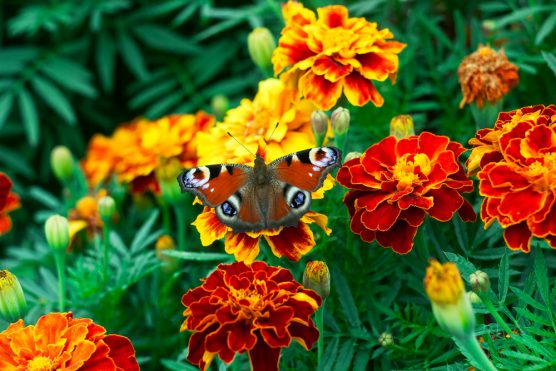
Tagetes or marigold flowers hold its place among the first flowers of many gardeners and all the credit would go to this low-maintenance plant for its easygoing nature. Marigolds come in four different types- African, Triploid, French, and Single. They differ from each other in size and color and most of them are easily available at your local nursery.
The blossoms can be red, fiery orange, and yellow in color and all of them attract pollinators like bees and butterflies. You can keep the seeds from spent blossoms and use it to set the display for next year.
Marigolds are a versatile flower that enjoys full sun and they grow the most on hot days. They can grow well on both dry or moist soil and therefore it is widely used in bedding and container plants. Once they are established on the ground, they need minimal care and you can even increase the blooming time length by deadheading spent blooms.
22. Glorybower
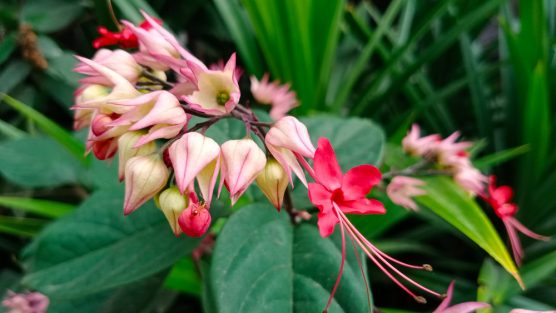
Clerodendrum bleeding heart, also known as glorybower, is a sub-tropical vine that wraps around a trellis or sticks for support. They produce striking crimson and white flowers amidst the shiny green foliage.
A houseplant in cooler climates, glorybower can be a dazzling addition to your garden if you want butterflies to stop and look for nectar. They perform best in partial shade, but they can tolerate full sunlight provided there is enough moisture. Grow it in rich, fertile, and well-drained soil and the bleeding heart would be very happy at heart!
23. Globe Amaranth
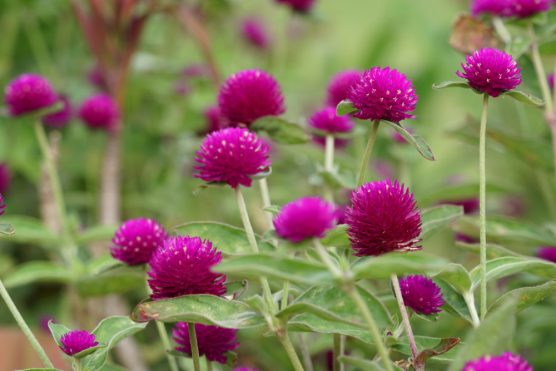
Gomphrena globosa or globe amaranth is a tender annual that can reseed itself for years and bless us with consistent blooms. The plant care is very easy for globe amaranth and those pretty round blooms do attract butterflies and beneficial garden pollinators. They can grow up to 12 inches tall when fully mature.
The flowers form clusters of florets that look like large clover blooms and having a wide range of colors like pink, white, yellow, and lavender. They also make excellent bouquets and can brighten up your interiors with its stunning beauty.
Globe amaranth loves full sun with good drainage and any type of soil except alkaline. They perform very well in garden soil and keep the soil moderately moist. It can also tolerate dryness and it is better than overhead watering as it can result in powdery mildew.
24. Aster
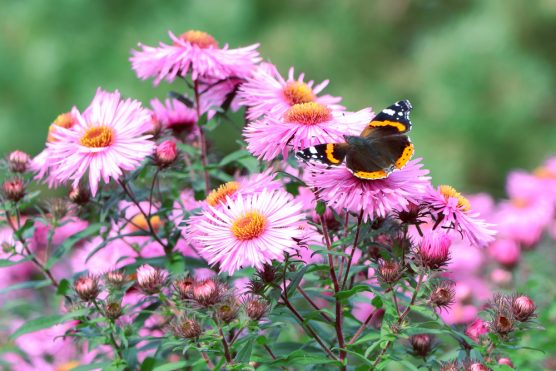
Almost every variety of aster flowers are itself a wonder and you can never get enough of that beauty. Aster flowers bloom in late summer and they add eye-catching and vibrant colors amidst the autumn landscape. These star-shaped flowers are very rewarding and when paired with coneflowers and goldenrod, they put up a heavenly display.
Plant it in a full sun zone with loamy, well-draining soil. The plant requires more water during the blooming season and you must keep it moist all the time. Don’t get water or fertilizers on the foliage as aster plants are prone to mildew and fungal diseases.
Asters do need little more care when compared to low-maintained plants as they need deadheading and mildew control occasionally.
25. Calendula
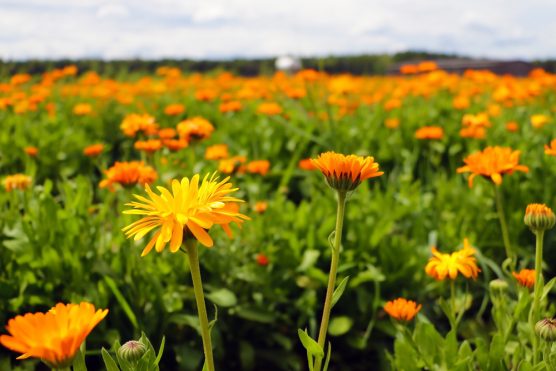
Historically used for culinary and medicinal purposes, calendula bears bright yellow and orange flowers that are also called pot marigold for some varieties. Calendula flowers have been a staple in British home gardens as those showy petals are used in cooking, the coloring of cheese, and many more.
If grown in a vegetable garden, calendula draws aphids away from the valuable veggie plants. This flowering herb is an annual and can make butterflies take a stop in its center floret and savor the rich nectar.
Choose a shady location as these flowers last longer in filtered sun and ensure occasional watering of the plant is established. Cool temperatures and well-draining, poor to average soil are the optimum conditions for calendula flowers to blush!
26. Alyssum
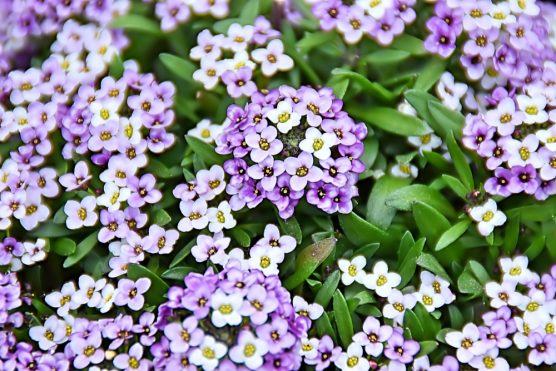
One of the very few drought-resistant annual plants, sweet alyssum is a flowering plant native to the United States. They are known for their lively fragrance and self-sowing capabilities. Species like Alyssum maritimum are useful in alpine rock gardens, can be a very good border plant, and even do good in hanging baskets, planters, and dry zones.
The plant produces clusters of tiny flowers in clumps that come in pink, white, salmon, yellow, and purple colors. The blooming season is June to October and rebloom is encouraged by cutting back spent flowers.
Alyssum needs full sun, good drainage with moderate moisture to live happily. It can thrive in partial shade as well and watering only when the soil is dry. It is prone to root rot and you should look out for this. Also, sweet alyssum is one of the favorite flowers of butterflies!
27. Delphinium
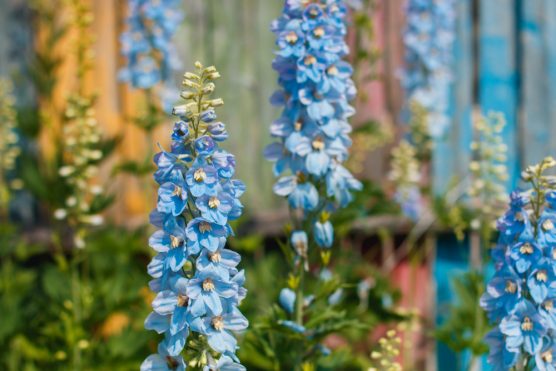
One of my favorites from the lot, delphinium has got dazzling, spiky blooms on tall and towering stems that come in a wide range of colors. Impart color to the summer garden with numerous hybrid shades like pink, red, lavender, white, yellow, and the most common- blue. Many people think that it is a high-maintenance plant, but nothing is impossible, right?
Grow delphinium in a sunny spot and keep the soil moist consistently with the help of mulch that can retain moisture. The soil must be well-draining and neutral to slightly alkaline soil is optimum. Gentle morning sun, afternoon shade if you live in hot climates and maintaining the fertilization requirements, that’s it.
Make those spiky blooms a go-to zone for butterflies and hummingbirds in the summer. With proper care, you can even expect a bountiful blast of beautiful blooms in the late summer or early autumn!
28. Fennel
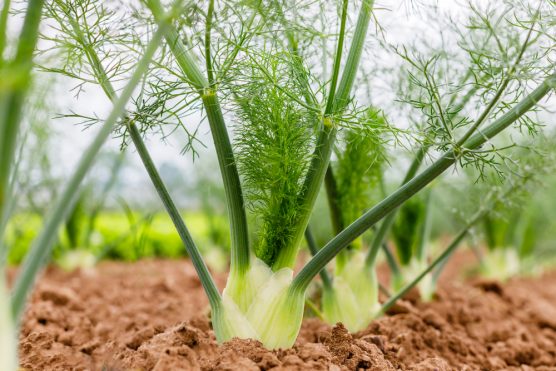
Foeniculum vulgare or the fennel herb has a history of medicinal usage before it was brought back to Europe by early traders. Today, it is well-recognized for flavoring eggs and fish with its crisp anise aroma and is grown in gardens all over the world. It is one of the few herbs that can be grown by seeds and they perform way better than root division.
Grow fennel in a sunny location with a well-drained bed and you will see the blooms in the second year. Butterflies are attracted to the nectar in these herbs and you can expect regular visits of pollinators soon after the blooms have been established.
29. Lavender
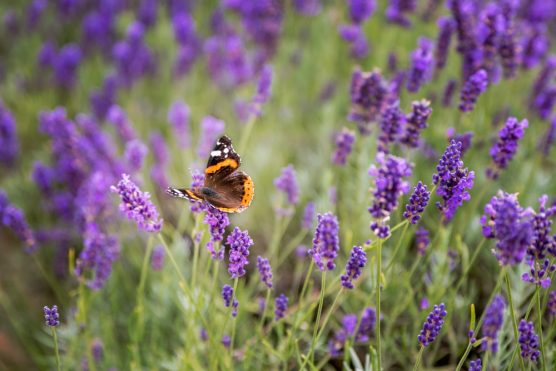
Lavandula angustifolia or lavender is a commonly grown herb plant, well-known for its aroma and spectacular medicinal properties, is an easy-care plant that can also be used as a landscape setting. This herb enjoys hot and dry conditions, they are drought-resistant and the blooms are very showy, perfect to add beauty to your garden.
Lavender thrives best under sunny, warm conditions with well-drained, rich, and alkaline soil. The plant cannot tolerate moist or wet soil and needs plenty of air circulation to reduce the chances of root rot.
Lavender also possesses excellent calming properties and lavender essential oils are very popular across the world. Having such a beneficial herb in your garden would not only help you in numerous ways but also attract butterflies to your garden!
30. Oregano
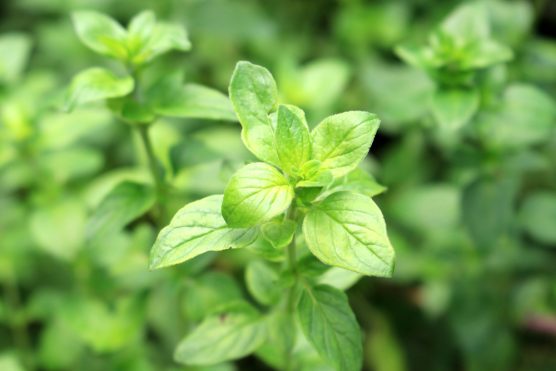
Origanum vulgare or oregano is very famous in indoor herb gardens and is native to hot and arid regions. This herb is an amazing companion for vegetable gardens as they can repel insects and pests that affect beans and broccoli.
Oregano has ample amounts of nectar that attracts butterflies and other pollinators to the herb garden and brings nature in. So much more than just a pizza topping, right?
Locate oregano in a place with full sun and well-drained soil with good air circulation. This hardy herb needs to be watered only during excessively dry periods and they don’t need to be fertilized as they can take care of themselves. To enhance the flavor, pinch the flower buds as they begin to bloom.
31. Sage
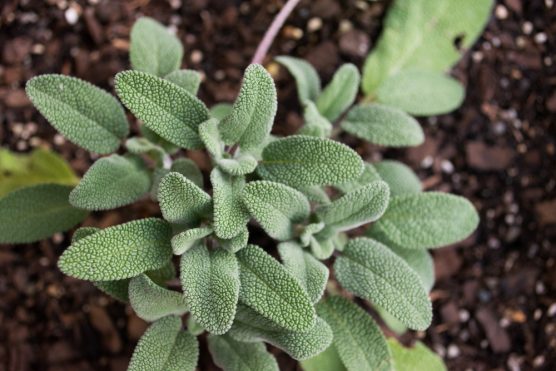
Salvia officinalis or sage can be an amazing addition to your home garden if you want to cook delicious meals regularly. Growing this edible sage plant is easy and it is a quite rewarding herb. There are green sage, purple sage, golden sage, and tricolor sage, and you can choose any for your herb garden.
Since butterflies are attracted to herbs, you can consider adding sage to your garden. Plant a sage in full sun and give it well-draining soil as they hate it when the roots are wet. Sage comes from hot and dry climates and their best-growing conditions are related to their native origin as well.
32. Stonecrop
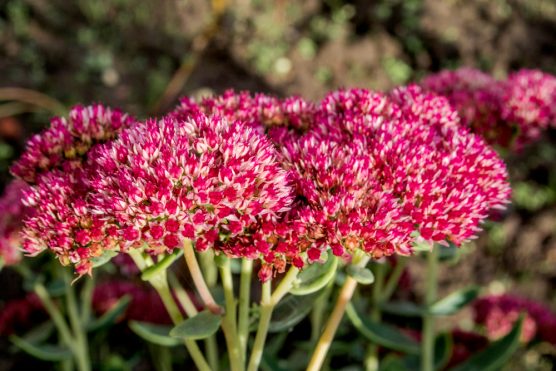
A succulent sedum plant, stonecrop is suitable for arid areas of a garden and it is also a well-known houseplant. If you want an easier plant project, you should go for this easy maintenance and hardy species. This perennial has a rosette form that produces reddish-maroon flowers rich in sweet nectar and attracts butterflies, bees and moths.
The stonecrop perennial thrives in hot and sunny locations and it would need well-drained soil, rich in organic nutrients. Young plants should be watered every few days and the mature plants do not need supplemental water if there is normal rainfall. Stonecrop is a wonderful container plant, it looks amazing in rockeries and even as a part of perennial borders.
33. Scabiosa
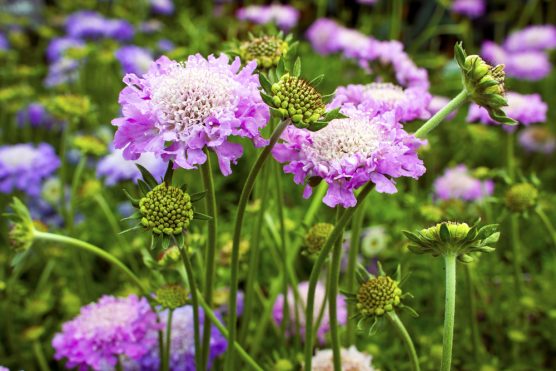
Scabiosa, also known as pincushion flower, could be an amazing addition to your flower garden. They are easy-care plants that can thrive almost anywhere and they put out a magical sight to behold. They attract butterflies and scabiosa is suitable for bed, borders, and cutting gardens.
The pincushion flower has a cushion-like center with pin-looking stamens and they form an attractive summer bloomer. The color ranges from blue, white, and purple amidst a lush blue-green to gray foliage. Scabiosa has both annual and perennial species and other color varieties like deep-maroon and lavender blue.
Most of the species of scabiosa are hardy and blushes in temperate climates. They do not like cold, but they hate overly wet conditions. Full sun and organic-rich, well-draining soil and watering in drought-like conditions would be enough for scabiosa to live a healthy life.
34. Musk mallow
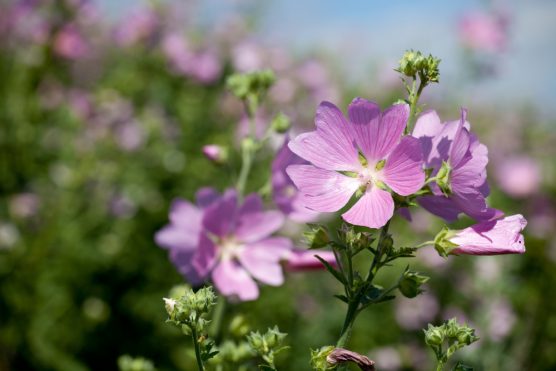
A very close cousin of the traditional hollyhock, musk mallow is a fuzzy perennial with palm-shaped leaves with flowers often used for ornamental purposes. The blooms are five-petaled and they decorate your garden from early summer until autumn. The colorful flowers of Australian hollyhock attract scads of butterflies and honeybees that couldn’t resist its sweet nectar.
Though it has now become invasive in parts of the United States, musk mallow is a hardy plant that can tolerate poor, thin soil with very low nutrients. Keep the soil moist during warm weather and choose a location with full sunlight or partial shade. Once established, the musk mallow plant won’t ask much from you instead give you rosy-pink blooms every year.
35. Nasturtium
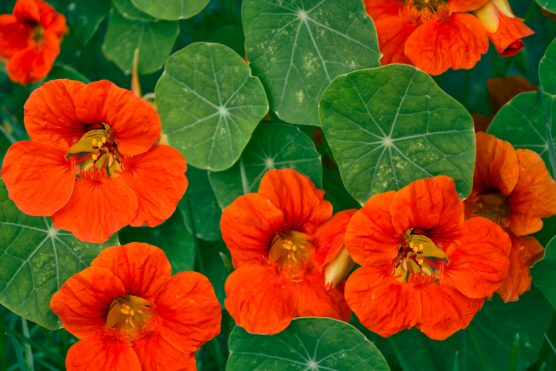
Are you looking for an attractive and edible flowering plant? Nasturtium is here to make your garden super attractive with its colorful and versatile flowers. There are about 50 varieties of this species and the blooms range from the big, dwarf, and variegated together with the foliage which is often used for ornamental uses.
Nasturtium adds a peppery taste to salads and it is also used to decorate cakes. The blooms are also used as a spiller in window boxes and decorated with hanging baskets. This edible plant is used in vegetable gardens as aphid traps and they also lure butterflies and other pollinators to take a stop in its vicinity.
This hardy plant can thrive on neglect and care of nasturtium is minimal. They love to be in full or part sun area and the blooms are amazing in well-drained but otherwise poor quality soil. Fertile soil or adding fertilizers might result in lush foliage and smaller blooms.
36. Day Lily
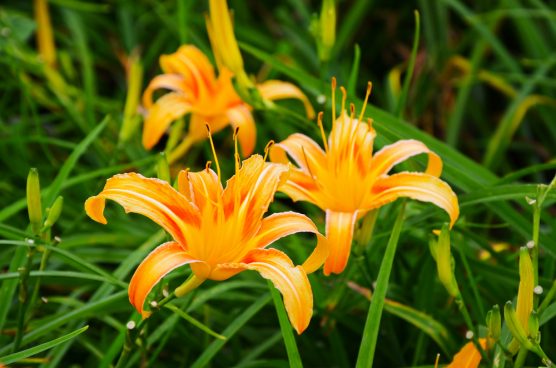
Hemerocallis or daylilies has always been a favorite of gardeners because they make a welcome addition to a garden and a mature clump can produce almost 400 blooms! Some traditional species die in winter while some varieties are semi and evergreen. Planting daylilies both as single specimen and ground cover puts forward a divine sight, worth drooling.
Caring for daylilies is super easy as they even thrive on neglect. They prefer slightly acidic soil and at least six hours of sun every day and the morning sun is the best, especially in warm areas where the afternoon soon can scorch the leaves. After planting daylilies, keep the plant well hydrated for a few weeks and let the roots establish.
You need to fertilize it during spring which is the blooming season and remove the seed pods to encourage healthy growth. Daylilies are enriched with sweet nectar that attracts flocks of butterflies and you would be proud of yourself that you did it!
37. Dianthus
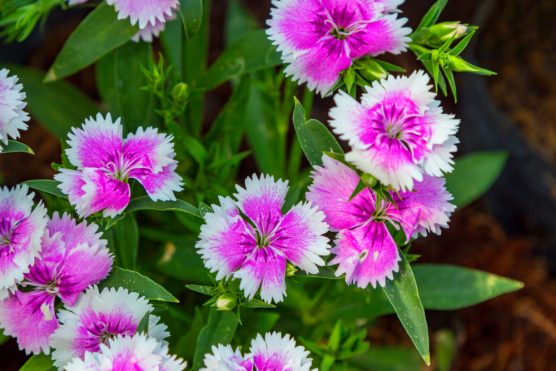
Dianthus flowers, also called pinks, belongs to the carnations category of plants and is widely recognized by the spicy fragrance of the blooms. The species has annual, biennial and perennial varieties and the blooms are mostly used in borders or potted displays. These pretty blooms are very quick to attract nectar-sucking beings like butterflies and birds as well.
Dianthus flowers are mostly pink with some white, salmon, and red varieties amidst the slender and sparsely spread foliage on thick stems. The color is whitish around the edges of the petals while the center is darker. The prolonged bloom period is from May to October and it might be stretched if you know how to grow dianthus well.
Pinks need full sun or partial shade, it must receive six hours of sun daily. They love alkaline soil which has good drainage and watering only at the base to keep the foliage dry and prevent mildews. To encourage additional blooming, applying fertilizers every six to eight weeks and deadheading is very important.
38. Buttonbush
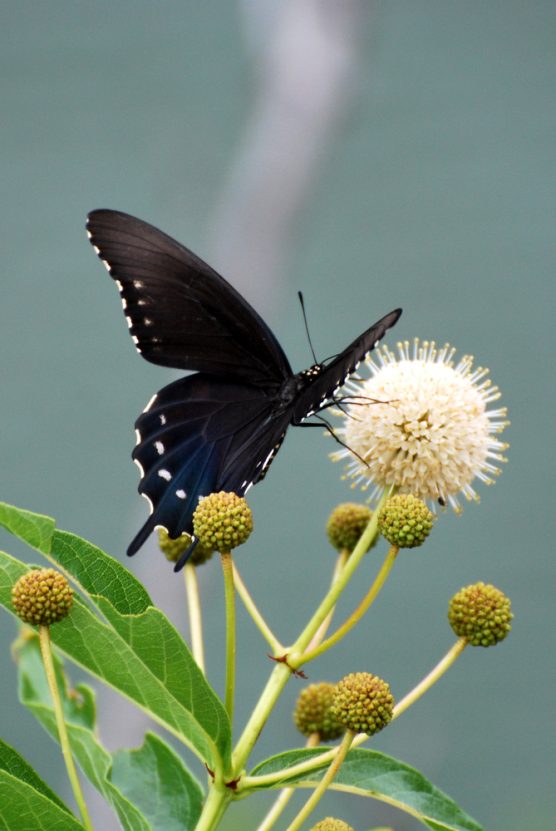
A unique plant that loves to live in moist locations, buttonbush is a shrub that dwells in garden ponds, riverbanks, swamps, rain ponds, and anything that is consistently wet. It has alternate names like buttonwillow, swamp wood, and buttonwood. They have very pretty summer blooms that look like ping pong balls with spikes and is also known as Honeyball or little snowball.
Buttonbush is a beneficial plant in so many ways like they provide seeds for geese, shorebirds, and songbirds. They can efficiently attract hummingbirds and butterflies which would end up as every day’s garden guests. Also, the twigs and leaves of a buttonbush shrub serve as an excellent deer snack and this could be a fair warning for you!
Buttonbush would probably be the happiest if you leave it alone in a wet location with full or partial sun. This plant is self-sufficient and it hates to be fussed over.
39. Itea Sweetspire
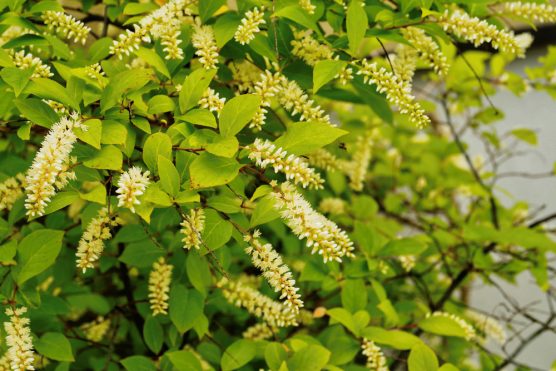
The Itea sweetspire could be a stunning addition to your butterfly garden, always maintaining a dazzling display with little care from the gardener. They possess attractive foliage with bottle-brush white flowers that appear in spring and pleases butterflies with its sweet nectar. Interestingly, the green foliage of Itea sweetspire can turn into yellow, orange, mahogany, or red in the fall while the blooms are always white.
Locate the plant in full sun to get fragrant racemes and use moist to wet soils to maintain healthy blooms. This drought-tolerant species makes an excellent display in Fall with the foliage bearing shades of different colors.
40. Pansy
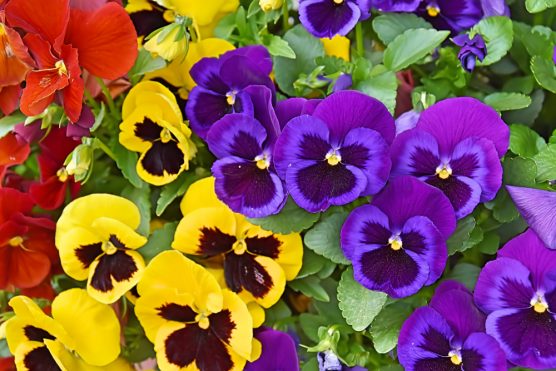
Pansy plants or Viola × wittrockiana are among the first flowers of the winter season and they are colorful and cheerful. While tropical pansies bloom throughout the winter, other varieties are grown in late fall or early spring. Being a part of the viola family, pansies are best for landscapes, flower bed borders, and even in hanging baskets for indoor decor.
Pansies prefer well-prepared, acidic soil and regular watering in the blooming season. Some hybrid varieties prefer full sun, but most of them prefer a daytime temperature of 16 degrees and not more.
The heart-shaped, overlapping petals come in several bright colors like yellow, purple, pink, magenta and they are super reliable, throughout the year. Besides, they are butterfly magnets and with pansies around, you will surely welcome butterflies as your regular visitors!
As a gardener or plant enthusiast, watching your garden come alive with butterflies amidst those colorful blooms is nothing less than wonderful. These plants would help you build or restructure your butterfly garden. Choose your favorites from the list and you would be proud of yourself very soon!

